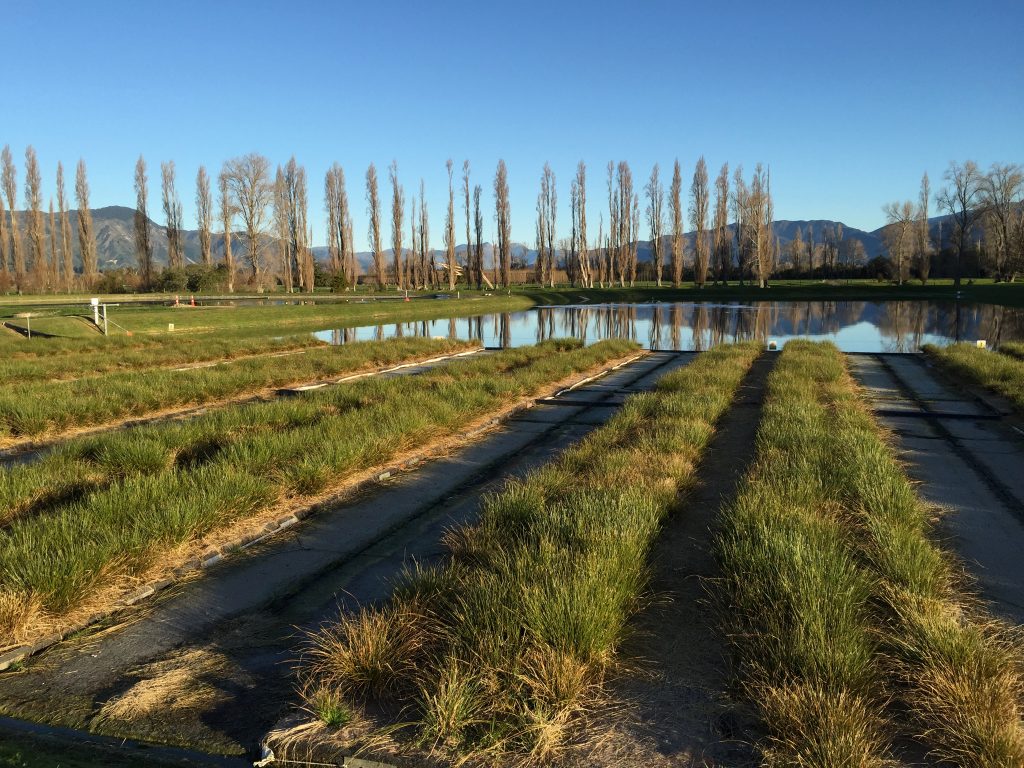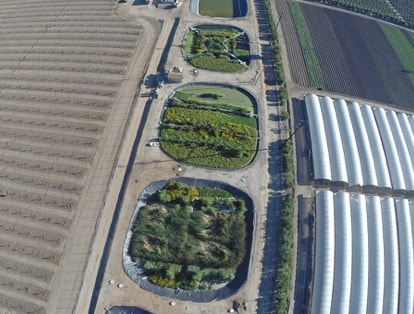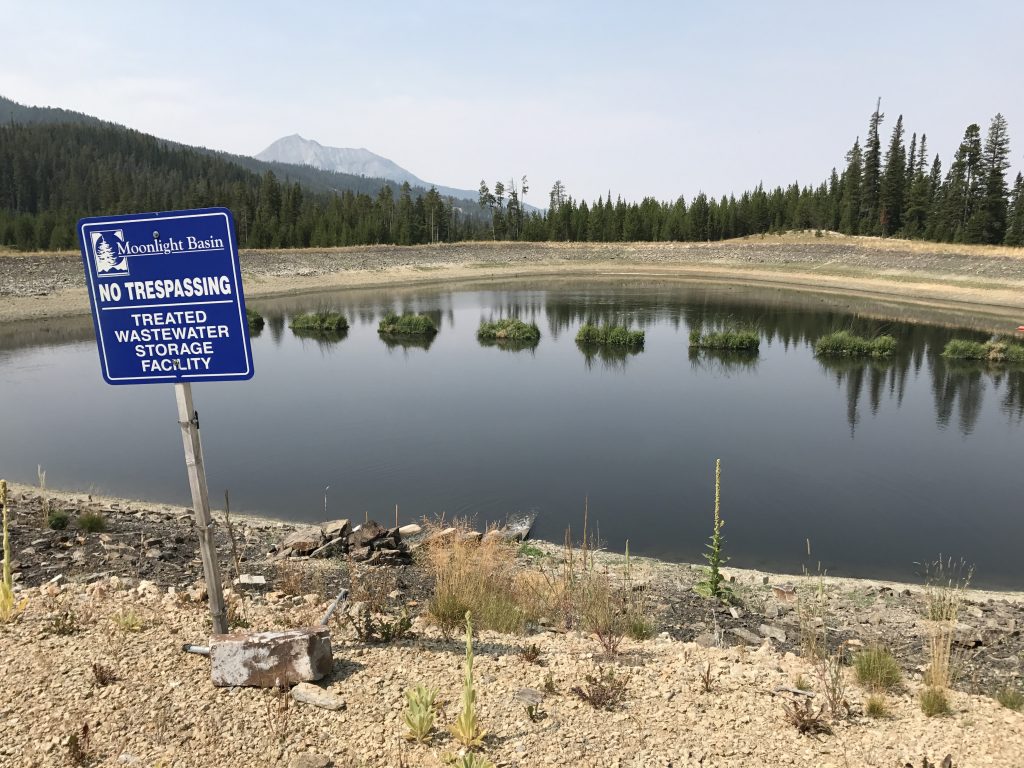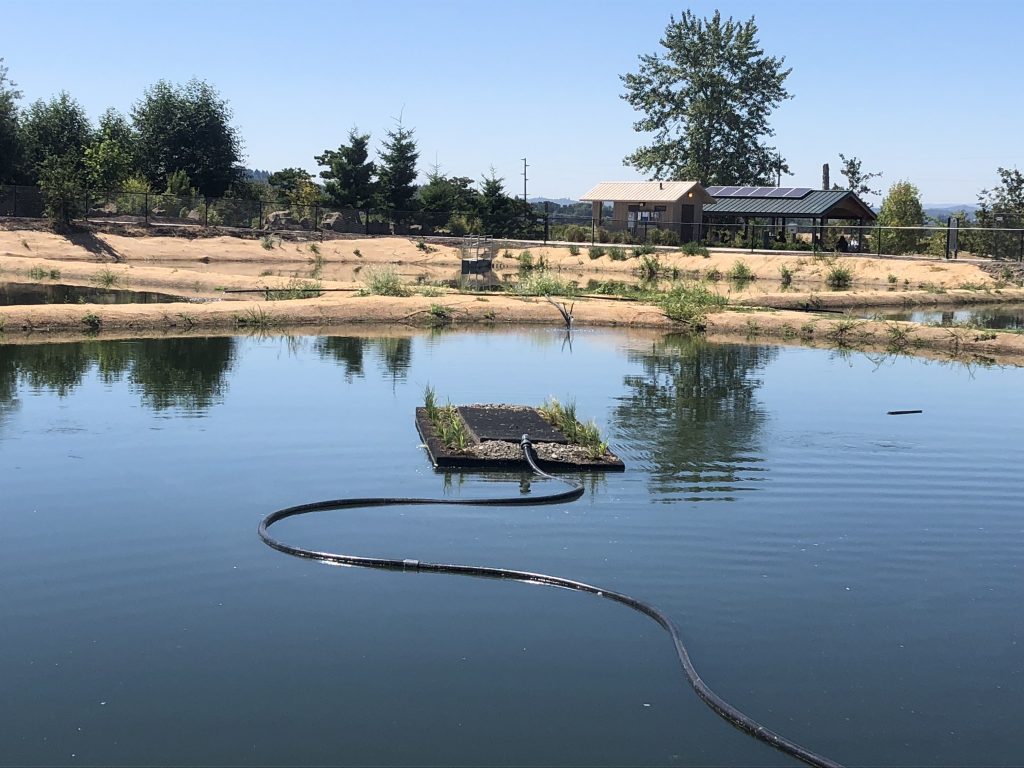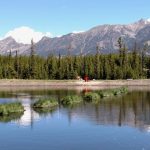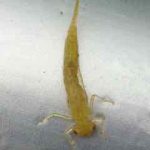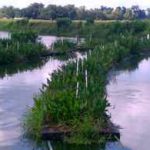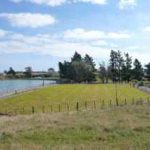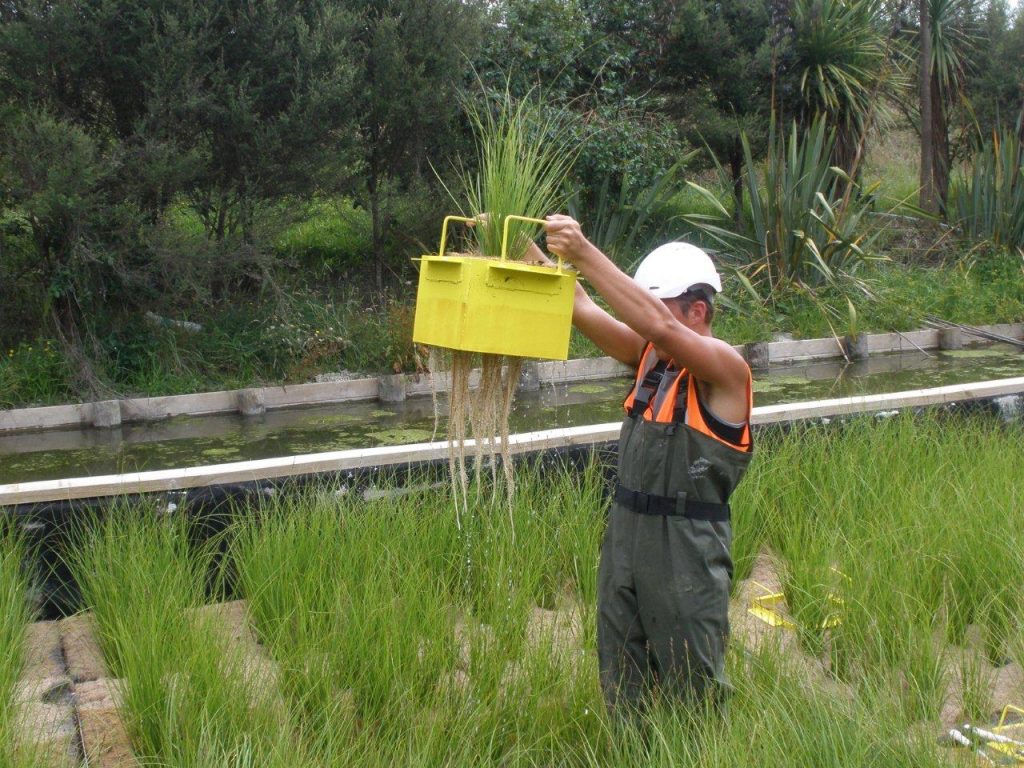Treating wastewater lagoons with BioHaven Floating Islands can mean huge savings for the small community struggling to meet discharge standards.BioHaven lagoon treatment can extend the life of lagoons and buy the community time until an expensive upgrade is called for. Large treatment facilities can utilize BioHavens to polish their tertiary effluent and even achieve Water Resource Recovery (WRR) through harvesting marketable products, such as forage fish or trees. Retrofitting existing assets with BioHavens is straightforward, non-disruptive and scalable.
How a BioHaven Floating Island Works in Wastewater Lagoon Treatment
BioHavens promote a type of fixed-film treatment that employs bio-reactive processes in combination with plant remediation. The floating island matrix provides an effective treatment surface as water is circulated through the fine mesh to promote biofilm growth. As plant roots grow unimpeded through the permeable matrix, a massive surface area is created within and beneath the island to accommodate the bacteria that consume organic matter and nutrients in wastewater. Suspended solids are digested (organic) or sloughed off (inorganic). The symbiosis between plants and microbes increases both microbial activity and plant growth to provide an unsurpassed, natural, inexpensive water-cleaning approach.
|
The main function of floating islands in removing pollutants from effluents is:
- Growth of plants, and biofilms on matrix and root surface, uptakes phosphorus.
- Aerobic and anaerobic bacteria, which co-exist within the biofilms, promote nitrification / denitrification and BOD removal.
- Plant roots assist in filtering and settling TSS.
- Mild acidification of water due to release of humic acids, and a C input from senescent vegetation; assisting denitrification.
- Ammonia removal requires aeration for nitrification and anoxic conditions for denitrification. Both processes occur simultaneously in BioHaven treatment under aerobic conditions.
- Cold-weather ammonia removal, which is a temperature-dependent process, has been effective with BioHaven systems (Rehberg Ranch, Billings, MT).
Can BioHavens help with "peak phosphorus" recovery?
The BioHaven StreamBed is a unique configuration that uses a high-capacity airlift blower to direct flow into a channel (or stream bed) formed by a cut-out in the top surface of the matrix, with matrix layers underneath. The world's supply of phosphorus is finite (has reached its peak) and is on a path to depletion. Being able to recover wasted phosphorus where it harms the aquatic ecosystem and re-use it appropriately is imperative. The StreamBed channel can accommodate phosphorus capture products, such as Biochar, which can easily be removed, disinfected and re-used for soil amendment. The circulation and accessibility provided by the BioHaven StreamBed make it extremely applicable for peak phosphorus capture and reuse.
What about sulfate removal?
Specific challenges, such as sulfate removal, can be effectively targeted with hyper-accumulator plants, which our partner Intrinsyx Bio specializes in. Use of such plants in an aquatic environment, including wastewater, is very feasible using BioHaven technology.
Cost savings through retrofitting
Since it can be retrofit to an existing asset, a BioHaven solution requires low capital investment compared to traditional mechanical systems. BioHaven solutions also have very low operating and maintenance costs.
Flexibility to fit your lagoon treatment needs
BioHavens can easily be adapted to suit a wide range of situations. They can:
- Fit into any existing lagoon or polishing pond
- Work within the energy limitations of the facility
- Operate in cold climate or extreme environmental conditions
- Be adjusted to manipulate specific treatment conditions
- Be installed in stages to meet changing treatment requirements
- Utilizing a proprietary BioHaven-specific modeling tool, system sizing is optimized
- Our engineers understand the resource recovery environment and remediation technologies
- Installation and service contracts available.
Features
- BioHavens are enhanced for long life in a wastewater setting. Non-corrosive fixtures, tethering to external bollards and environmentally-safe coatings protect the system components.
- Passive BioHavens planted with bushy-rooting perennials, maximize surface area and existing circulation patterns. Islands can be effectively deployed where power savings are desired. Specially-designed curtains can be installed to prevent short-circuiting.
- BioHaven Forced-Flow StreamBeds, which use an efficient airlift blower, are ideal for cold-weather treatment where they are effective under ice and are designed to limit temperature loss.
- Access walkways can be installed for plant maintenance on large systems to reduce O & M costs and facilitate harvesting.
- BioHaven technology is an ideal platform for Water Resource Recovery (WRR), capitalizing on the ability of nutrients to grow into biomass that can be harvested and utilized beneficially.
- Expected lifespan is 20 – 30 years.
Water Resource Recovery
The future of Water Resource Recovery (WRR) is viewing the contaminants in wastewater as resources to be recovered rather than problems to be eliminated. In larger Water Resource Recovery Facilities (WRRFs), the end-products are typically various types of water re-use, phosphorus recovery and re-use (among other goals). BioHavens have a part to play in resource recovery, through growth and harvest of potentially beneficial plants or fish, that may have commercial or other value. Examples of this are:
- Hyper-accumulator plants that take up selenium can be harvested and ground up to be added to selenium-poor soil or feedstock.
- Minnows can be propagated using the biofilm, protozoa and macro-invertebrates present in BioHavens as food, then harvested and sold as bait fish.
- Landscape trees and shrubs can be grown to a certain size using fertilizers (phosphorus) present in the water and harvested for re-use.
- Resource Recovery Facilities can be used to grow breed stock for valuable native species, such as the eels harvested and released from a facility in New Zealand.
- The positive footprint associated with using phosphorus in situ, plus the potential of the actual harvest to offset initial installation costs, assures a role for BioHavens in the forward-thinking Water Resource Recovery environment.
Treatment Benefits
The typical wastewater contaminants of concern can be treated by manipulating the BioHaven treatment processes, even at cold temperatures:
- Odor mitigation
- BOD removal
- Phosphorus removal
- Nitrification and denitrification
- TSS removal
- Fecal coliforms removal
- Tertiary polishing
- pH stabilization
Case Studies and Research
CH2M Hill study measuring nutrient removal by BioHaven technology in waste water
BioHaven Floating Islands technology enables this Louisiana wastewater facility to stay in compliance and win an EPA award
Marton Waste Water Treatment: First-of-its-kind floating island “Lid” eliminates odor, reduces BOD and cuts annual operating costs
|
Marton, New Zealand
In this innovative application of a BioHaven floating island from New Zealand, a blanket or lid is built to cover and treat a pond anaerobically, thereby reducing troublesome odors which had until then plagued the residents of Marton. This treatment option was highly successful in improving the effluent, and saved the city approximately $150,000 in annual operating costs. |
Related Articles
Power of the People
The idea that small communities can operate sustainably energizes the FII team. Part of this energy comes from the people we serve, as they pick up on the vision of their community operating on such a holistic basis. People just get it!
Imagine that today, your village’s wastewater empties right into the local trout stream. And no one talks about fishing for a mile or two downstream from town. There is a real solid reason for this. But that’s today. Tomorrow, you can send water by those trout that does them no harm. People get this. And when you show them a system that pays for itself in the process, they end up feeling really good about where they live.
Imagine that today, your village’s wastewater empties right into the local trout stream. And no one talks about fishing for a mile or two downstream from town. There is a real solid reason for this. But that’s today. Tomorrow, you can send water by those trout that does them no harm. People get this. And when you show them a system that pays for itself in the process, they end up feeling really good about where they live.
What is Water Resource Recovery?
The concept of extracting valuable product from your wastewater facility. It means that the wastewater industry is now being purposeful about more than just making polluted water safe. Now there is serious direction around extracting value from this water. Here’s another way of saying this…”water needs to pay for itself.” If you live on a lake or own a pond, for example, the line might go…”grow fish instead of algae.”
Today with BioHavens you can also grow beautiful pollinator plants, or harvestable landscape trees. These trees are planted in islands as seedlings, then harvested to be replanted as valuable trees on shore once they reach a two inch caliper. In the meantime, they’ve been extracting pollution. And BioHavens are designed to be replanted, to repeat the cycle.
Today with BioHavens you can also grow beautiful pollinator plants, or harvestable landscape trees. These trees are planted in islands as seedlings, then harvested to be replanted as valuable trees on shore once they reach a two inch caliper. In the meantime, they’ve been extracting pollution. And BioHavens are designed to be replanted, to repeat the cycle.
Letting Nature Do Her Work as Part of Lagoon Treatment
This can happen commercially on wastewater lagoons, or in a lake or pond. Bring unhealthy water systems back to health. What’s amazing is how easy this is. It’s as if all we do is turn nature loose! It’s as if all we have to do is “give” her permission!
Extracting valuable product from large, concrete and steel wastewater facilities has been in the works for years now. But not so with small lagoon based facilities, until right now. BioHaven’s WRR system can operate in essentially any size lagoon facility. Are there economies of scale that argue for large lagoons? Not necessarily. Let’s say your system is handling just 40,000 gallons per day, which would make you a village of about 500 people, based on the 80 gallon per day per person number we typically use to estimate wastewater volume. You might have a three lagoon system, with each cell essentially the best part of one acre.
In such a setting our system would target operating on the third lagoon. We might cover two thirds, or perhaps the whole lagoon, with BioHavens. Generate local energy with solar BioHavens. You could even plant and harvest valuable crops on top of the island, or grow fathead minnows underneath. This relatively small wastewater system can pay for itself in a reasonable time frame.
It’s difficult for public officials to justify spending the amount of money needed to fix water, in the face of so many other pressing demands for that money. If you are really going to fix water, the water resource recovery system should:
In such a setting our system would target operating on the third lagoon. We might cover two thirds, or perhaps the whole lagoon, with BioHavens. Generate local energy with solar BioHavens. You could even plant and harvest valuable crops on top of the island, or grow fathead minnows underneath. This relatively small wastewater system can pay for itself in a reasonable time frame.
It’s difficult for public officials to justify spending the amount of money needed to fix water, in the face of so many other pressing demands for that money. If you are really going to fix water, the water resource recovery system should:
- Generate Revenue sufficient to show a reasonable ROI
- Be aesthetically pleasing
- All without creating a large O&M burden
BioHaven® Wastewater Products
Other BioHaven® Solutions
|
|
|
|
